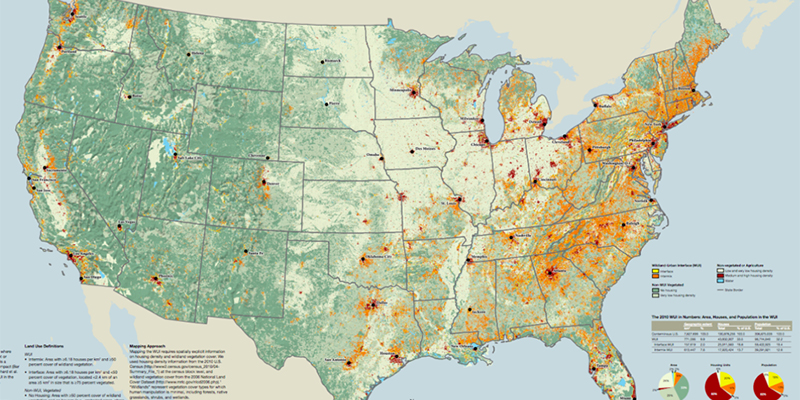The threat of wildfire is increasing in the United States. In 2015, more than 68,000 wildfires in the United States burned more than 4,636 structures and 10 million acres — the highest number of acres burned on record. The annual estimates on structure loss due to wildfire have increased dramatically for more than six decades.
President Obama yesterday signed an Executive Order on Wildland-Urban Interface Federal Risk Mitigation, which will mitigate wildfire risks to Federal buildings located in the wildland-urban interface (WUI), reduce risks to people and help minimize property loss to wildfire. The Obama administration announced the executive order at the White House Roundtable on Wildfires in the Wildland-Urban Interface, which was attended by Georgia State Fire Marshal Dwayne Garriss, who serves as Vice President of the ICC Board of Directors.
For new buildings and alterations to existing buildings greater than 5,000 square feet on Federal land within the WUI at moderate or greater risk to wildfire, the Executive Order directs Federal agencies to apply wildfire-resistant design provisions delineated in the 2015 edition of the International Wildland-Urban Interface Code (IWUIC) published by the International Code Council, or an equivalent code, which encompasses the current understanding of wildfire hazard potential and will help increase safety and protect the lives of people who live or work in these buildings.
"The annual estimates on structure loss due to wildfire have increased dramatically over the past six decades as a result of multi-year drought conditions in combination with accumulated fuel loads, growing populations residing in the wildland-urban interface, and associated increases in the exposure of built environments," the order says. "As such, we must continue to ensure our Nation is resilient to wildfire in order to promote public safety, economic strength and national security."
This marks the latest in a series of White House support for resilient building codes and standards to address the impact of climate change and natural disasters. President Obama declared May as National Building Safety Month to recognize and pay tribute to those who ensure the safety and resilience of the nation's buildings, and to reaffirm the U.S. commitment to upholding and abiding by strong and effective building safety standards. That was followed by the White House Conference on Resilient Building Codes that highlighted the critical role of building codes in furthering community resilience.
Industry professionals recently heard testimony and took action on proposed changes to ICC's 2018 Group B International Codes, including all chapters in the International Wildland-Urban Interface Code, during the ICC 2016 Group B Committee Action Hearings, April 17-27, in Louisville, Ky. Proposed changes to the 2015 edition of the International Wildland-Urban Interface Code can be viewed here.
|





